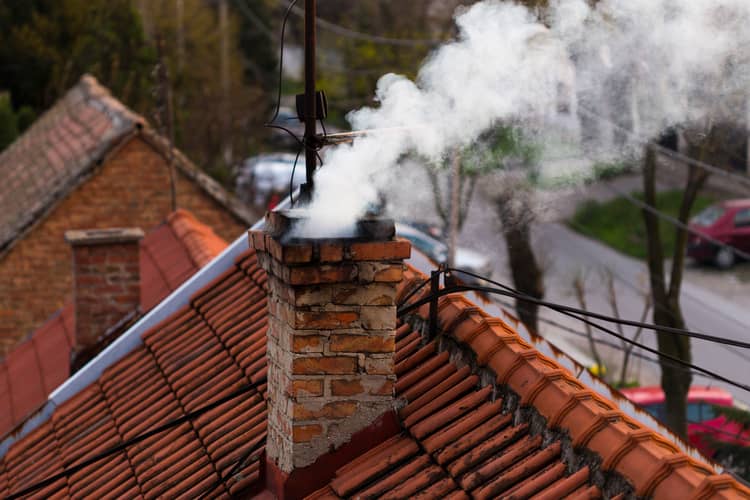A fireplace flue is the vertical passageway within the chimney through which smoke, hot gases, and other byproducts of a fire are vented to the outdoors. It’s an essential component for the safe operation of a fireplace, ensuring that combustion fumes are properly expelled from your home. It is important to know how to open a fireplace flue. In this article, we will learn how the flue is related to the damper, how to open a fireplace flue, information about the dampers, and maintenance.
Let’s learn more!
How is the Flue Related to the Damper?
The damper is a movable plate placed within the flue that regulates the draft and flow of air in and out of the chimney. When open, it allows smoke and other gases to exit through the flue, and when closed, it seals off the chimney, preventing drafts from coming into the house and heat from escaping.
How to Open a Fireplace Flue?
To open a fireplace flue, follow these steps:
- Ensure the fireplace is cold and not in use.
- Locate the damper handle inside the fireplace just above the firebox.
- Depending on the type of damper, push up, pull down, or rotate the handle to open it.
- Make sure the damper is fully open before lighting a fire.
How Do You Know If a Fireplace Flue is Open?
It is important to know if a fireplace flue is open. This can be done by:
- Visual Inspection: Shine a flashlight up the chimney to see if the damper is in the open position.
- Feeling for Drafts: Place your hand near the flue opening; if you feel a draft, the damper is likely to open.
- Checking for Light: During daylight, if you can see light at the top of the chimney, the flue is open.
- Smoke Test: Light a small piece of newspaper and hold it up to the damper opening; if the smoke rises up the chimney, the flue is open.

What is a Damper?
A damper is a device designed to regulate the airflow in and out of your fireplace chimney. It can be opened to allow the fire to receive oxygen and to let exhaust gases escape or close when the fireplace is not in use to increase energy efficiency and prevent downdrafts.
How to Check the Controls and Open the Damper?
Now that you know about the flue, it is important to know about opening the damper. First, locate the damper control near the front of the fireplace, which could be a knob, lever, or chain. Then, manipulate the control as per the manufacturer’s instructions—push, pull, or rotate—to disengage the damper. Lastly, check to ensure that the damper has fully opened by using one of the methods mentioned.
Types of Dampers
There are a few types of dampers and they are in different places of the chimney.
Throat Dampers
Installed above the firebox at the bottom of the chimney and operate with a handle or lever.
Top-Sealing Dampers
Located at the top of the chimney and controlled by a cable that extends down into the fireplace.
Why You Can’t Start a Fire Without the Flue and Damper Open
Starting a fire without opening the flue and damper will cause smoke, carbon monoxide, and other hazardous gases to enter your living space instead of being vented outside, posing serious health risks and potential for carbon monoxide poisoning.
What If You Can’t Open the Damper?
If the damper won’t open, it may be stuck due to rust, debris, or malfunction. Do not attempt to force it. Check for obstructions or damage and clean as required. Also, if the issue persists, refrain from using the fireplace and seek professional help.
Maintaining the Fireplace Flue and Damper
It’s important to know how to properly maintain the flue and damper. While regular inspections by professionals are essential, there are also things homeowners can do to keep their fireplace system functioning properly. For example, cleaning the chimney regularly can help prevent blockages and buildup that could cause the damper to malfunction.
Importance of Using Proper Fuel For the Fireplace
Burning the wrong type of fuel can cause excessive smoke and soot buildup, which can damage the flue and damper over time. By using the right type of fuel, homeowners can help ensure the longevity and safety of their fireplace system.
Best Protective Measures
Now that you know about opening a fireplace flue, let’s take a look at a few measures to protect your fireplace and keep it functioning. One of those is to determine which wood to use. Before going to burn just any wood in your fireplace, you might want to determine the best types to use. Read up on whether burning pine in your fireplace is a good idea. Also, be sure to check which wood is most effective for a quality fire.
Next, be sure to look into getting your chimney cleared. It is important to conduct maintenance on your chimney that ensure it isn’t clogged. You wouldn’t want to start a fire with a clogged chimney. The smoke will end up in your home and not leave the chimney.
Lastly, decide what type of fireplace fits your needs. You might end up wanting a gas fireplace instead of a wood-burning fireplace. Be sure to read up on the pros and cons of either fireplace. You will need to take necessary precautions like adding carbon monoxide detectors in your home if you go with a gas fireplace or any type of gas appliance.
When Do I Call a Professional?
You should call a professional if you are concerned about a few things. One of those is if the damper will not open or close correctly. Also, if there is visible damage to the damper or flue. Another one is if you aren’t sure how to safely operate the damper. Lastly, if you need help with the cleaning, maintenance, or inspection of the damper.
Check out the video below about how to open a fireplace damper.
Conclusion
Maintaining a functional flue and damper is crucial for the safety and efficiency of your fireplace. Ensuring they are open before starting a fire will prevent dangerous fumes from accumulating in your home. Annual inspections by professionals are highly recommended for optimal operation and to identify any potential problems with your fireplace system. While taking care of the fireplace, damper, and flue, it is a great time to have a home inspection. This is a good time to contact Enviroquest Home Inspections for a complete home inspection in Harrisburg, PA.
